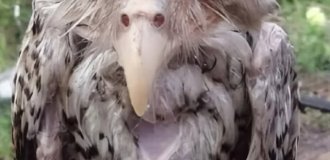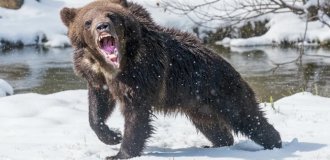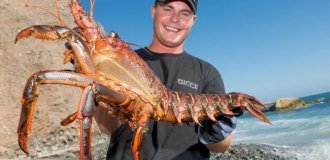Unusual ways of protection in different animals (15 photos)
Many predators are armed with sharp fangs, powerful claws, strong grip, as well as incredibly developed vision, hearing and smell. Actually, how to protect yourself from such deadly hunters? But not it is worth underestimating the peaceful representatives of the world of fauna. They know for themselves stand. Some use the skill of disguise, while others themselves can release claws and spikes.
bagworm caterpillar 
The bagworm caterpillar is distinguished by its unusual approach to self defense. Only having been born, she begins to build her own shelter of silk-woven particles of leaves, bark, twigs and lumps of soil. This house resembles the shape of a bag, hence it went on its own the name of a family of butterflies.
Caterpillar of butterflies of the genus Hemeroplanes 
True masters of mimicry! These caterpillars know how to scare everyone around - just pretend to be a snake.
armadillo lizard 
When the lizard is frightened, it takes its tail into its mouth and rolls into clew. In this form, the armadillo lizard is protected from predators by a thick square scales along the back and spikes on the tail.
spiny turtle 
Spiny turtles are harmless animals, despite their sharp spikes along the edges of the shell and a toothed keel located on the ridge. But it is these protrusions that help young individuals defend themselves from enemies. BUT dark brown color often gives them the opportunity to merge with fallen foliage.
Caterpillar nicknamed "The Mad Hatter" 
Why the mad hatter? Everything is simple. She builds a tall hat out of her own old heads to protect herself.
Tarantula spider Celaenia excavata 
“Pretend to be feces and stay alive” is the slogan of this spider. Having taken the not entirely attractive appearance of feces, the spider is not considered birds as a possible food source.
Vietnamese moss frog 
To merge with the environment is a frequent salvation for many inhabitants of the natural world. This also applies to the moss frog, which looks like moss.
Thorny devil (moloch) 
The thorny devil mainly feeds on ants. And his awesome spikes on the back and head help it scare away predators.
Cuiaba pygmy frog 
The cuiaba pygmy frog has two "false eyes" on its back body. She only lifts her up when threatened. danger. Thus, the frog scares off predators. But if the predator is not deceive with eye-spots, and he decides to approach, then the frog can take advantage of the unpleasant secretions that come from the glands, located in the place of these spots.
golden tortoise beetle 
The shell in the form of a tortoise shell not only gives a curiosity to this beetle, but also protects it well from ill-wishers.
Gorilla 
It is better not to anger this beast and not to fight with it. Apart from superhuman strength, they have extremely dangerous bites. Their bite in twice as powerful as a lion.
Sperm whale 
Self-defense of the sperm whale is very unusual. They often release a cloud red-brown liquid that resembles blood in color to escape from an attacking predator.
Sea cucumber 
Sea cucumbers discard parts of their intestines to scare away and defend against potential predators such as crabs and fish. Organs are regenerated in a few days by cells inside the sea cucumber.
Koala claws 
Koala and her cute appearance conquer the heart andadults and children. But you should be careful, an angry or frightened koala can not only leave unforgettable scratches with their sharp and long claws, but also very painful to bite.
Margay 
Margay is the best climber of all wild cat species. Him specially adapted claws and ankle joints, which allow him to rotate his ankle 180 degrees. He can to overcome the forest canopy almost like a monkey.
Dexterity, tenacity and cunning are the salvation of a predator from larger relatives.





















